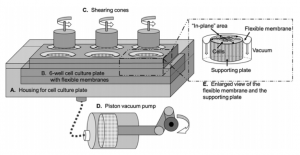Coronary artery disease (CAD) is the most common cardiovascular disease, and cardiovascular diseases remain the leading cause of death in the United States. Atherosclerosis, or the buildup of plaque deposits along arterial walls, is the major contributor to CAD, and can eventually result in heart attacks. The vascular endothelial cells that line arteries are sensitive to changes in mechanical signaling. In physiological conditions, vascular endothelial cells are subject to cyclical stretching from the regular contraction and relaxation of the artery, as well as shear stress from the flow of blood through the vessel.
Pathological conditions of stenosis due to plaque buildup can drastically alter flow patterns. At the site of the stenosis, there is both arterial stiffening (lower stretch stress) and increased fluid flow (higher shear stress); on the other side of the blockage, arterial stiffness may return to normal but shear stress is lower in this recirculation zone. In Dr. Yin’s lab, I am looking at how altered mechanical stress affects endothelial cells.
 Using a flexible culture membrane, we use a device that applies stretch to the endothelial cells. At the same time, cones placed in the cell culture media above the cell apply fluid shear stress, allowing us to look at the effect of both on them. By recreating different atherosclerotic stress conditions (physiological, at the stenosis site, pathological recirculation zone) we can examine how these conditions affect endothelial cell morphology and expression of inflammatory factors that may contribute to further plaque deposit.
Using a flexible culture membrane, we use a device that applies stretch to the endothelial cells. At the same time, cones placed in the cell culture media above the cell apply fluid shear stress, allowing us to look at the effect of both on them. By recreating different atherosclerotic stress conditions (physiological, at the stenosis site, pathological recirculation zone) we can examine how these conditions affect endothelial cell morphology and expression of inflammatory factors that may contribute to further plaque deposit.